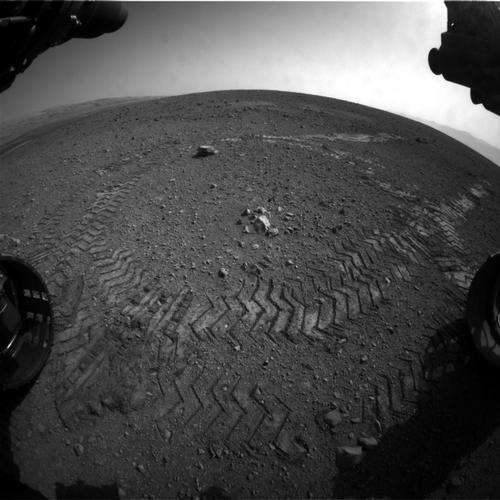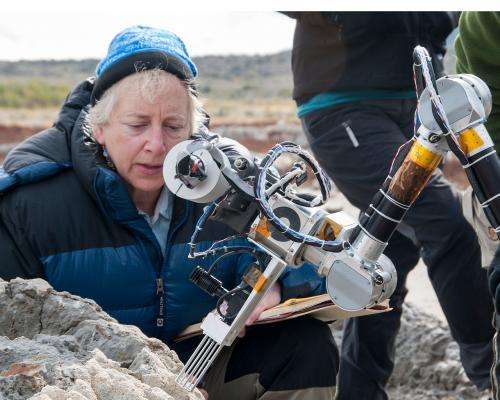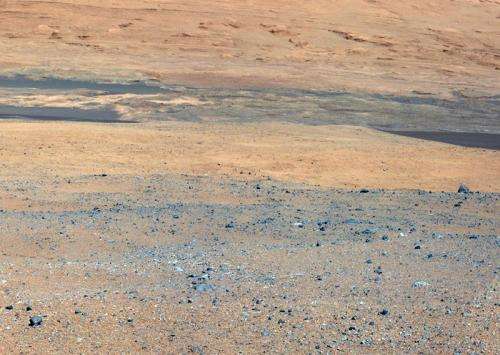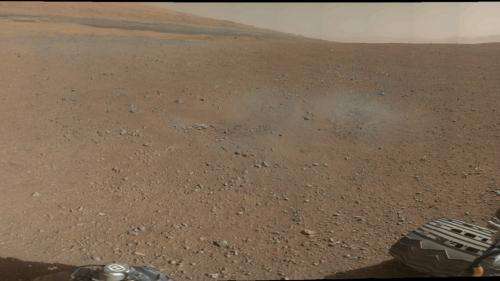Curiosity in it for the long haul

In recent days, Curiosity has accomplished a number of firsts, including the first use of its laser to zap a nearby rock and its first short drive. Many more such firsts lie ahead. But as the rover prepares to head off on a journey of discovery across previously unexplored territory, it seems like a good time to pause and remind ourselves just what it was that Curiosity was sent to Mars to do.
MSL (Mars Science Laboratory) is not a life-detection mission. Its goal is not to look not for life, but rather to investigate whether Mars was ever capable of supporting life. It is searching for signs of habitability.
Some people are disappointed by that.
But, says Pan Conrad, "I don't think we have broad enough consensus in the scientific community about how to define life so universally that we would recognize it on Mars." Conrad is the deputy principal investigator for SAM (Sample Analysis at Mars), one of Curiosity's scientific instruments. "I can't think of a single thing that we would see that any of us would say, 'Aha, we have found life.'"
Of course, if one of Curiosity's many cameras were to catch a dinosaur, or even a caterpillar, strolling by, it would be hard to deny that Mars is a living planet. But there's slim chance that will happen. If life ever did take hold on Mars, it's unlikely to have evolved beyond single-celled, microbial life.
Indicators of microbial life, however, especially in ancient rocks like those Curiosity will investigate, can be devilishly difficult to nail down. Debates still rage within the scientific community about whether certain textures and chemical signatures in 3.5-billion-year-old Australian rocks, some of the oldest rocks on Earth, are the remains of ancient biology or mere evidence of abiotic chemical reactions.

"We're not ready to really target the biology," says Mary Voytek, senior scientist for astrobiology at NASA headquarters and deputy program scientist for MSL. Although in recent years significant work has been done on DNA-detection chips, the scientific-instrument package for MSL was decided on before such chips were available. Even if MSL did contain a DNA detector, says Voytek, "We'd be asking the question, 'Is there life on Mars that looks exactly like the life that's here on Earth?'" But life on Mars, if it ever took hold, may have followed a different chemical trajectory than terrestrial life. So rather than looking for evidence of the specific chemistry that characterizes life on Earth, MSL is tasked with studying a more abstract question: habitability.
"To understand what might represent life, you have to understand environmental context," says Conrad. "Until we understand the contextual stuff on Mars, in a million years we wouldn't be able to say, 'This is definitively life.'"
The search for habitability focuses on three environmental factors: water, carbon and energy.
"You'd need a solvent," says Voytek, "and water's the best." There is widespread evidence of water in Mars's past. Erosional features - river channels and alluvial fans – that formed in the distant past. Present-day ice, detected beneath the martian surface by orbiting spacecraft and seen up-close at the Phoenix landing site. Even tiny droplets seen in a handful of images on the legs of the Phoenix spacecraft, which some scientists believe was water condensation.
Mars's inventory of carbon is also of great interest. Although meteorites containing amino acids rained down on early Mars, just as they did on early Earth, little is known about carbon chemistry on the Red Planet. Carbon-bearing minerals have been difficult to detect from orbit. But if there was ever life on Mars, "there's no reason to believe it's not going to be carbon based," says Voytek.

And then there's the question of energy. Life is at its essence a set of chemical reactions. Microbes take advantage of reactions that occur naturally in the environment, catalyzing those reactions, making them "go a little faster," says Dawn Sumner. And then, "instead of releasing the energy to the environment, they capture it in their carbon bonds." Sumner, a professor of geology at UC Davis, is one of the long-term planners for MSL. She has spent much of her career analyzing ancient rocks on Earth. So what it means to say that MSL is designed to search for habitability is that Curiosity has onboard a set of instruments that can study these three critical components of habitability.
It can examine in detail how water has moved through or pooled in a region, and for how long it was present; it can look for long-chain hydrocarbon molecules, the building-blocks of life; and it can study the mineralogy of rocks to learn what kinds of chemical reactions have taken place over time, and how much energy those reactions may have made available for life to utilize.
Gale Crater is an ideal site for conducting that study.
NASA's Opportunity rover, near its landing site in Meridiani Planum, found a number of minerals – hematite, gypsum, jarosite – that form in the presence of water. Based on those discoveries, scientists were able to say that, for some period of time, the Merdiani region, and by implication other regions on Mars, was habitable.
But for how long? Long enough for life to originate? Long enough for it to gain a foothold? It's hard to say. The slice of geologic time represented by the terrain that Opportunity investigated is too short. It's like a snapshot of a single moment in martian history.

Gale Crater, on the other hand, is a virtual museum wherein millions, perhaps billions, of years of martian history are on display. It's one thing to say that a particular location, for a moment in time, was habitable; that life, if it existed, could have survived there. But life doesn't emerge overnight. The question Curiosity is tasked with answering is not whether habitable conditions ever existed on Mars, but whether they presisted long enough for life to emerge and to gain a planetary foothold. That requires studying hundreds of millions of years of martian geologic history.
And that is precisely what is sitting in front of the rover, mere miles away. Mount Sharp, a 3.4-mile-high mountain in the center of Gale Crater, is believed to contain a geologic record of Mars's ancient past, from an era, early on, when water was more plentiful, through a later era during which that water dried up and disappeared. Scientists are hopeful that the secrets held within that sequence of rocks, secrets that the instruments aboard Curiosity will be able to tease out, will reveal whether Mars was habitable long enough to become a living world.
That understanding will not come quickly. It will be a year or more before Curiosity even arrives at the base of Mount Sharp and begins to study its sedimentary layers. In the mean time, there will no doubt be exciting discoveries. Mars always has surprises in store for its robotic explorers: the MER discovery of hematite "blueberries" in Meridiani Planum, for example, or the discovery of perchlorate in the soil at the Phoenix landing site. But piecing together the story of martian habitability is going to take a while.
Oh, and one final thought. Even if Mars turns out not to have been a suitable venue for the emergence of life, Gale Crater will still have valuable lessons to teach us about biology. That may sound odd, but you see, from the perspective of a geologist interested in what a planet looks like before life emerges on it, Earth is all but useless.
"It's not likely we're ever going to find rocks on Earth that we can show are prebiotic," says Sumner, rocks that date from a time "before life evolved." What plate tectonics haven't buried, biology has chewed up and altered.
But "if there's never been any life on Mars," she adds, "exploring Mars" may provide unique insights that enable us "to understand the origin of life on Earth."
Source: Astrobio.net




















